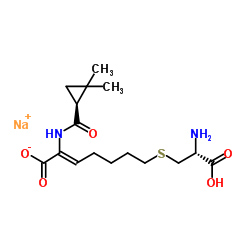81129-83-1
| Name | cilastatin sodium |
|---|---|
| Synonyms |
2-heptenoic acid, 7-[[(2R)-2-amino-2-carboxyethyl]thio]-2-[[[(1S)-2,2-dimethylcyclopropyl]carbonyl]amino]-, monosodium salt, (2Z)-
[R-[R*,S*(Z)]]-7-[(2-Amino-2-carboxyethyl)thio]-2-[[(2,2-dimethylcyclopropyl)carbonyl]amino]-2-heptenoic Acid Monosodium Salt MFCD01723687 W-13 hydrochloride 2-heptenoicacid,7-((2-amino-2-carboxyethyl)thio)-2-(((2,2-dimethylcyclopropyl Cilastatine Cilastatin sodium salt Natrium-(2R)-2-amino-3-{[(5Z)-6-carboxy-6-({[(1S)-2,2-dimethylcyclopropyl]carbonyl}amino)hex-5-en-1-yl]sulfanyl}propanoat Sodium (2R)-2-amino-3-{[(5Z)-6-carboxy-6-({[(1S)-2,2-dimethylcyclopropyl]carbonyl}amino)hex-5-en-1-yl]sulfanyl}propanoate Cilastatin Sodium Sodium (2Z)-7-{[(2R)-2-amino-2-carboxyethyl]sulfanyl}-2-({[(1S)-2,2-dimethylcyclopropyl]carbonyl}amino)hept-2-enoate Sodium hydrogen 7-[(2-amino-2-carboxylatoethyl)thio]-2-[[(2,2-dimethylcyclopropyl)carbonyl]amino]hept-2-enoate Sodium 7-(2-amino-2-carboxy-ethyl)sulfanyl-2-(2,2-dimethylcyclopropyl)carbonylamino-hept-2-enoate Sodium Cilastatin (2R)-2-amino-3-{[(5Z)-6-carboxy-6-({[(1S)-2,2-diméthylcyclopropyl]carbonyl}amino)hex-5-én-1-yl]sulfanyl}propanoate de sodium Sodium (2Z)-7-{[(2R)-2-amino-2-carboxyethyl]sulfanyl}-2-({[(1S)-2,2-dimethylcyclopropyl]carbonyl}amino)-2-heptenoate monosodiumsalt,(r-(r*,s*(z)))-)carbonyl)amino) 2-Heptenoic acid, 7-[[(2R)-2-amino-2-carboxyethyl]thio]-2-[[[(1S)-2,2-dimethylcyclopropyl]carbonyl]amino]-, sodium salt, (2Z)- (1:1) EINECS 279-694-4 (2Z)-7-[[(2R)-2-Amino-2-carboxyethyl]thio]-2-[[[(1S)-2,2-dimethylcyclopropyl]carbonyl]amino]-2-heptenoicacidsodiumsalt (Z)-7-[(R)-2-Amino-2-carboxyethylthio]-2-[(S)-2,2-dimethylcyclopropylcarbonylamino]-2-heptenoic acid 1-sodium salt Sodium (Z)-7-(((R)-2-amino-2-carboxyethyl)thio)-2-((S)-2,2-dimethylcyclopropanecarboxamido)-2-heptenoate |
| Description | Cilastatin sodium (MK0791 sodium) is a reversible, competitive renal dehydropeptidase I inhibitor with an IC50 of 0.1 μM. Cilastatin sodium inhibits the bacterial metallob-lactamase enzyme CphA with an IC50 of 178 μM. Cilastatin sodium is an antibacterial adjunct[1][2][3]. |
|---|---|
| Related Catalog | |
| Target |
IC50: 0.1 μM (Renal dehydropeptidase I); 178 μM (Bacterial metallob-lactamase enzyme CphA)[1] |
| In Vitro | Cilastatin (200 μg/mL; 24 hours; RPTECs) treatment protects against Vancomycin-induced proximal tubule apoptosis and increases cell viability, without compromising the antimicrobial effect of Vancomycin[2]. Apoptosis Analysis[2] Cell Line: Renal proximal tubular epithelial cells (RPTECs) Concentration: 200 μg/mL Incubation Time: 24 hours Result: Significantly ameliorated Vancomycin-induced nuclear apoptosis. |
| In Vivo | In a mouse model (female mice, strain CD-1, 20 g) of systemic infection, Imipenem plus Cilastatin can protect mice from S. aureus, E. coli, and P. aeruginosa infection[3]. |
| References |
| Boiling Point | 655.5ºC at 760 mmHg |
|---|---|
| Molecular Formula | C16H25N2NaO5S |
| Molecular Weight | 380.43500 |
| Flash Point | 350.2ºC |
| Exact Mass | 380.13800 |
| PSA | 157.85000 |
| LogP | 1.18910 |
| Storage condition | Desiccate at -20°C |
CHEMICAL IDENTIFICATION
HEALTH HAZARD DATAACUTE TOXICITY DATA
|
| Hazard Codes | Xi |
|---|---|
| RTECS | MJ9650200 |
